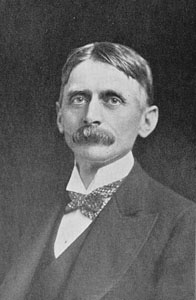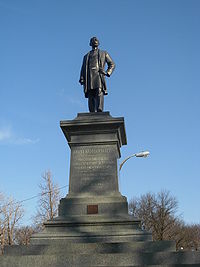
Edward Manning Bigelow
Encyclopedia


United States
The United States of America is a federal constitutional republic comprising fifty states and a federal district...
City Engineer and later Director of Public Works in Pittsburgh
Pittsburgh, Pennsylvania
Pittsburgh is the second-largest city in the US Commonwealth of Pennsylvania and the county seat of Allegheny County. Regionally, it anchors the largest urban area of Appalachia and the Ohio River Valley, and nationally, it is the 22nd-largest urban area in the United States...
, Pennsylvania
Pennsylvania
The Commonwealth of Pennsylvania is a U.S. state that is located in the Northeastern and Mid-Atlantic regions of the United States. The state borders Delaware and Maryland to the south, West Virginia to the southwest, Ohio to the west, New York and Ontario, Canada, to the north, and New Jersey to...
. He was responsible for major improvements in city's infrastructure
Infrastructure
Infrastructure is basic physical and organizational structures needed for the operation of a society or enterprise, or the services and facilities necessary for an economy to function...
, such as new boulevard
Boulevard
A Boulevard is type of road, usually a wide, multi-lane arterial thoroughfare, divided with a median down the centre, and roadways along each side designed as slow travel and parking lanes and for bicycle and pedestrian usage, often with an above-average quality of landscaping and scenery...
s, waterworks
WaterWorks
WaterWorks is a water park owned by Cedar Fair, located at the back of Kings Dominion in Doswell, Virginia. When it debuted in 1992, it was originally named Hurricane Reef...
, and parks, many of them in today's Oakland neighborhood
Oakland (Pittsburgh)
Oakland is the academic, cultural, and healthcare center of Pittsburgh and is Pennsylvania's third largest "Downtown". Only Center City Philadelphia and Downtown Pittsburgh can claim more economic and social activity than Oakland...
.
Biography
Edward Manning Bigelow was born in Pittsburgh on 6 November 1850. A Presbyterian, he attended Western University of Pittsburgh (today's University of PittsburghUniversity of Pittsburgh
The University of Pittsburgh, commonly referred to as Pitt, is a state-related research university located in Pittsburgh, Pennsylvania, United States. Founded as Pittsburgh Academy in 1787 on what was then the American frontier, Pitt is one of the oldest continuously chartered institutions of...
) as a civil engineering
Civil engineering
Civil engineering is a professional engineering discipline that deals with the design, construction, and maintenance of the physical and naturally built environment, including works like roads, bridges, canals, dams, and buildings...
student. In 1880 he married Mary Peabody; they had no children.
In the late 19th century Pittsburgh became a boomtown
Boomtown
A boomtown is a community that experiences sudden and rapid population and economic growth. The growth is normally attributed to the nearby discovery of a precious resource such as gold, silver, or oil, although the term can also be applied to communities growing very rapidly for different reasons,...
, known as a Steel City
Steel City
The Steel City is a common nickname for many cities that were once known for their production of large amounts of steel. With industrial production also in developing countries, like those in Eastern Europe and Asia, most of these cities do not produce as much steel as they used to...
for its high concentration of steel mill
Steel mill
A steel mill or steelworks is an industrial plant for the manufacture of steel.Steel is an alloy of iron and carbon. It is produced in a two-stage process. First, iron ore is reduced or smelted with coke and limestone in a blast furnace, producing molten iron which is either cast into pig iron or...
s. Bigelow, a close friend of Andrew Carnegie
Andrew Carnegie
Andrew Carnegie was a Scottish-American industrialist, businessman, and entrepreneur who led the enormous expansion of the American steel industry in the late 19th century...
, joined the city administration and was appointed City Engineer in 1880. The position was transformed in 1888 into Director of Public Works, a position he held for three terms of office
Term of office
Term of office or term in office refers to the length of time a person serves in a particular office.-Prime Minister:In the United Kingdom, the Prime Minister has no term limits...
, first from 1888 to 1900, again between Jul 1901 and Nov 1901, and then from 1903 to 1906. In 1911 the Governor of Pennsylvania named him as a commissioner of the newly formed State Highway Department from 1911 to 1915.
During his tenure of over thirty years, Bigelow saw the need for urban parks in a highly industrialized city and acquired land for public park use. As park commissioner in the 1880s, Bigelow convinced Mary Schenley
Mary Schenley
Mary Elizabeth Croghan Schenley is best remembered as a major philanthropist to the city of Pittsburgh, Pennsylvania, United States.-Early life and scandal:...
to donate land to the city in what became the Schenley Park
Schenley Park
Schenley Park is a large municipal park located in Pittsburgh, Pennsylvania, between the neighborhoods of Oakland, Greenfield, and Squirrel Hill. It is also listed on the National Register of Historic Places as a historic district...
, opened in 1889. He also acquired the land that would be used for the Highland Park
Highland Park (Pittsburgh)
Highland Park is both a large municipal park and a racially diverse, mostly residential neighborhood in the northeastern part of Pittsburgh, Pennsylvania.The neighborhood has 6,749 residents according to the 2000 United States Census...
(opened in 1893); spending more than $900,000 in city funds to buy the land, parcel by parcel, from farmers. As head of city planning in 1900, he started work on a system of grand boulevard
Boulevard
A Boulevard is type of road, usually a wide, multi-lane arterial thoroughfare, divided with a median down the centre, and roadways along each side designed as slow travel and parking lanes and for bicycle and pedestrian usage, often with an above-average quality of landscaping and scenery...
s (one of which, initially known as the Grant Boulevard, now bears his name, it was renamed in Bigelow's honor right after his death; others include the Boulevard of the Allies, Beechwood and Washington Boulevards) to connect the parks. His visions for park development made him unpopular with those who wanted to use the land for more building development, although he eventually triumphed. He also developed the water and sewer systems in Pittsburgh.
Barry Hannegan, director of historic landscape preservation for the Pittsburgh History & Landmarks Foundation, said in 2000 that "He (Bigelow) brought to Pittsburgh what we would we would now call state-of- the-art landscape architecture and horticulture" and "We owe him a lot. He was the first truly great planner in Pittsburgh."
He died on 6 December 1916, before taking the position of Public Works director for a fourth time. And he was interred in Homewood Cemetery
Homewood Cemetery
Homewood Cemetery is a historic, nonsectarian burial ground in Pittsburgh, Pennsylvania, United States. It is located in Squirrel Hill and is bordered by both Frick Park and the neighborhood of Point Breeze....
. On Dec. 20, 1916, Grant Boulevard was posthumously named Bigelow Boulevard in memory of him.

